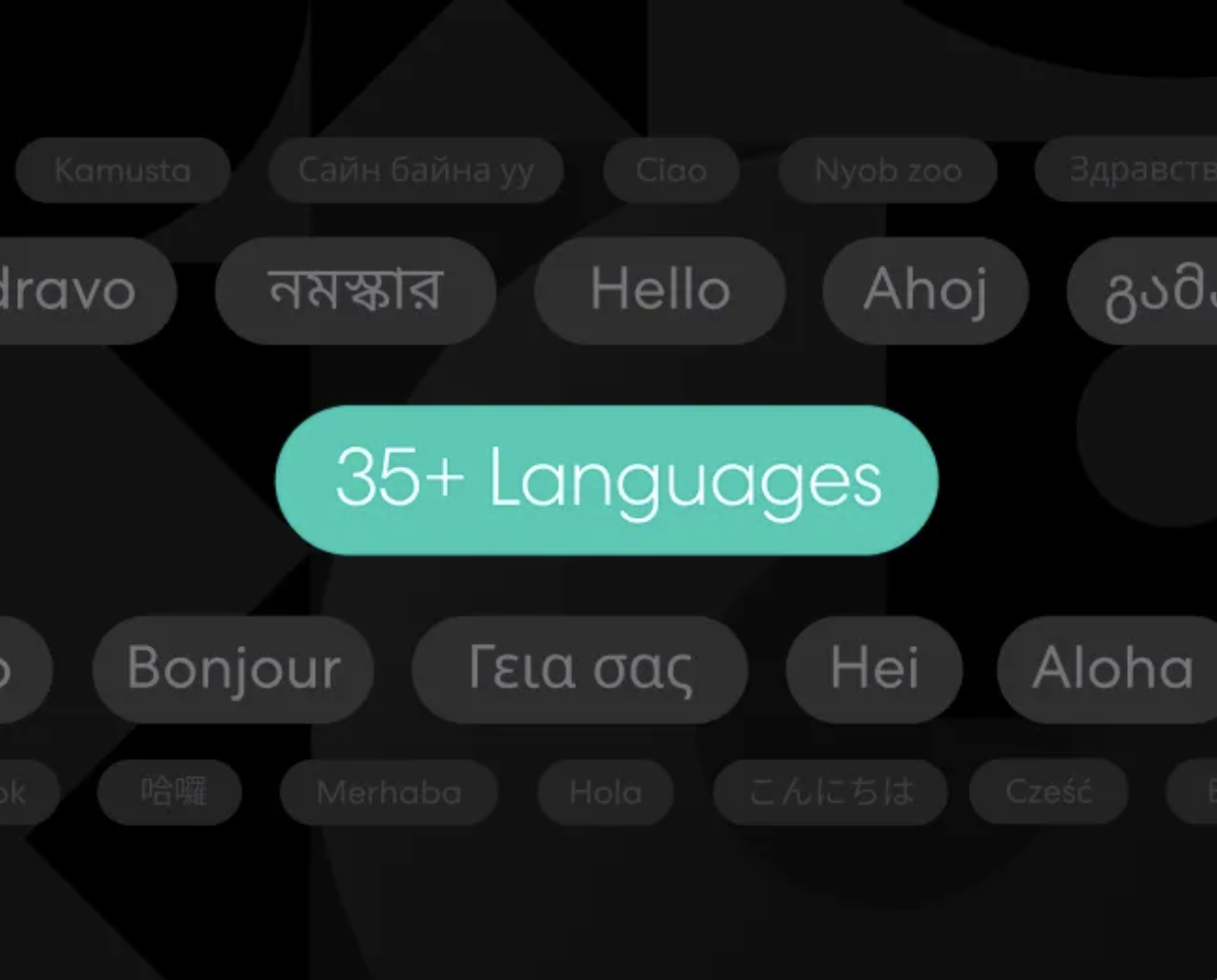
Research 101
Introducing: Poll Comparison - Streamline Concept Testing and Make Better Decisions Faster
Emmet Hennessy
November 24, 2025
Market Research
Articles

Research 101
Introducing: Poll Comparison - Streamline Concept Testing and Make Better Decisions Faster
Emmet Hennessy
November 24, 2025
Market Research
Articles

AI
Purpose-Built for Research AI is Here - a Letter from the CPO
Jessica Dubin
October 21, 2025
Market Research
Articles

AI
Purpose-Built for Research AI is Here - a Letter from the CPO
Jessica Dubin
October 21, 2025
Market Research
Articles

Advanced Research
Unlock Agile Global Insights: Using Remesh Multi-Language Conversations for Research Across Audiences
Customer Success Team
October 14, 2025
Market Research
Articles

Advanced Research
Unlock Agile Global Insights: Using Remesh Multi-Language Conversations for Research Across Audiences
Customer Success Team
October 14, 2025
Market Research
Articles

AI
The Prompt Is the New Moderator Guide
Anthony Lam
September 16, 2025
Market Research
Articles

AI
The Prompt Is the New Moderator Guide
Anthony Lam
September 16, 2025
Market Research
Articles

AI
Building an AI-Ready Research Stack: Beyond Data Preparation
Anthony Lam
September 9, 2025
Market Research
Articles

AI
Building an AI-Ready Research Stack: Beyond Data Preparation
Anthony Lam
September 9, 2025
Market Research
Articles

AI
Agentic AI for Research: A Practical Primer
Dan Reich
September 2, 2025
Market Research
Articles

AI
Agentic AI for Research: A Practical Primer
Dan Reich
September 2, 2025
Market Research
Articles

Advanced Research
Webinar Recap: Unlocking Depth at Scale - Remesh Video for Researchers
Customer Success Team
August 5, 2025
Market Research
Webinars

Advanced Research
Webinar Recap: Unlocking Depth at Scale - Remesh Video for Researchers
Customer Success Team
August 5, 2025
Market Research
Webinars

Transparency in AI: How Remesh Builds Trust Through Responsible Implementation
Ross Coudeyras
July 21, 2025
Articles

Transparency in AI: How Remesh Builds Trust Through Responsible Implementation
Ross Coudeyras
July 21, 2025
Articles

Advanced Research
Webinar Recap: Turning Employee Engagement Insights into Action with Remesh
Customer Success Team
June 16, 2025
Employee Research
Articles

Advanced Research
Webinar Recap: Turning Employee Engagement Insights into Action with Remesh
Customer Success Team
June 16, 2025
Employee Research
Articles
4 Organizational Structures That Won't Hold Your Team Back
Take a look at these frameworks for managing different business problems through the lens of systems improvement.



If the problem that's blocking your company from a successful transformation is organizational structure, it's time to take a look at some fresh ideas for governance at large.
While a collaborative team is central to organizational change, we believe at Remesh that there's still a need to avoid design by committee, and to trust in the skills and expertise of each member of your team, regardless of the organizational structure you choose. Ultimately, organizational structures should be built around the teams that use them – not the other way around.
While Scaled Agile Framework (i.e. SAFe) is by far the most popular organizational structure, other hybrid models are popular as well. Truly, choosing an organizational structure is unique to each company, and no one structure is better than another.
Read: 4 Behavioral Drivers of Transformation

Your business problem is lowering costs, use...
Lean Six Sigma Model
Lean Six Sigma is a structure that systematically removes waste. It combines Lean-Agile and Six Sigma (the improvement of quality by discharging defects in processes early) to eliminate various types of waste including Over-Production, Waiting, and Non- Utilized Talent. The waste itself does not refer to employees, but to employee output or lack thereof.
Lean Six Sigma Steps
This organizational structure depends on the hunting and gathering of information, and a complete feedback loop between teams and within individual teams.
- A workflow or process problem is defined within the organization, and the lead team (or head of one) infiltrates all teams across the organization to confirm the established definition.
- The lead team measures and analyzes the problem with the process or workflow. While it may be tempting to assume at this stage that the problem is speed, other types of waste may include talent gaps and prioritization structures.
- The lead team improves the defined problem by recommending change, then monitors and supports that change by closing the original communication loop.


Your business problem is quality improvement, use...
Crystal Model
Crystal is the preferred agile model of Alistair Cockburn, one of the founders of the agile movement. This structure believes in the power of teams to improve and optimize their own workflow, and that the owner (aka team) of a project is in the best position to decide on a project’s implementation – this includes the assumption that individual teams have all the knowledge they require to complete a project. In other words, Crystal is a beacon of transparency and autonomy, but it may be too fast and loose for organizations that tend to be more risk-averse or require a large safety net.
Read: Leading Agile Transformation (eBook)
This structure is ideal for quality improvement at speed since the structure requires high attention to detail for individual needs and a high likelihood of identifying errors or objections.
Crystal Steps
- The team defines a problem and outlines the project theorized to resolve the problem.
- The team reviews previous project processes and establishes unique timelines and metrics based on historic success.
- A retrospective is called following project completion to evaluate time to solution, team adaptability based on process, and recommendations for future project types.


Your business problem is early ROI, use...
Behavior-Driven Development Model
This structure is ideal for teams that struggle to prove early ROI or want to speed up their time to ROI because it incorporates customer or user feedback as a core team focus. There is increasing evidence that a laser focus on employee experience of customer feedback reaps incredible rewards. A study from CFI Group, for example, found that firms with superior customer satisfaction earn superior stock returns.
Read: How NASCAR Increased Revenue Through Customer Feedback
Behavior-Driven Development Steps
- Teams propose a user story for the product, and additionally, apply the “Five Why’s” principle to each story. This clearly ties each user story to a business outcome.
- Teams cut waste from product feature implementation by only incorporating updates or changes from the output of the “Five Why’s” exercise.
- The team communicates these behaviors in a simplistic way, which can be consumed easily by any department or other teams who wish to implement the successful strategy. This also increases access to institutional knowledge and improves the quality of future employee trainings.
Although this organizational structure may seem product-centric, remember that the root of technical problems are always a human problem. Implementing change in human process will directly affect your organization’s output, or your innovation management process.


Your business problem is product fit, use...Knowledge Management Model
Perhaps the most applicable to change management at the individual employee level, this structure values people over processes. Specifically, this organizational structure emphasizes knowledge sharing both horizontally and vertically throughout an organization to prevent recurring mistakes, to share lessons learned, and to inspire an innovative culture. You might think of KMAgile as the opposite of Crystal – while both structures have a core of knowledge sharing, Crystal places the responsibility of knowledge accumulation on the individual team, and KMAgile tasks the entire organization with the distribution of knowledge.
Deloitte Chief Information Officer Larry Quinlan recommends that organizations move toward the cloud for knowledge sharing, which can reduce cost and increase the inclusivity of knowledge beyond just HR executives, all while distributing a knowledge software budget cross-departmentally. This type of structure (KMAgile) increases exposure to positive results from knowledge sharing, which is a solution for one obstacle of adoption (i.e. will the change make work easier or better?).
This same type of knowledge sharing, when encouraged internally, can be replicated externally with customers. Use KMAgile for teams that face obstacles in competitive research and accessing market information.
Agile Knowledge Management Steps
- Key stakeholders and the project team meet to brainstorm on their knowledge base and how best to communicate cross-departmentally.
- Project team is trained in KM best practices and applies knowledge solutions to current problems or “quick wins”.
- The “quick wins” are categorized and communicated to the organization broadly for further application or reuse.
- In tandem with the three previous steps, an assessment occurs to establish current knowledge and preferred knowledge, including recommendations for future frameworks and strategies.


Other Organizational Structures
Of course, organizational structures are not limited to the few listed here. For a few extra ideas, download our eBook on Leading Agile Transformation, including detailed instructions for implementing structures like SAFe and LeSS.
{{cta('fdc1a9af-2b3c-4908-b357-f5911893b0a8','justifycenter')}}
-
Lorem ipsum dolor sit amet, consectetur adipiscing elit. Suspendisse varius enim in eros elementum tristique. Duis cursus, mi quis viverra ornare, eros dolor interdum nulla, ut commodo diam libero vitae erat. Aenean faucibus nibh et justo cursus id rutrum lorem imperdiet. Nunc ut sem vitae risus tristique posuere.
-
Lorem ipsum dolor sit amet, consectetur adipiscing elit. Suspendisse varius enim in eros elementum tristique. Duis cursus, mi quis viverra ornare, eros dolor interdum nulla, ut commodo diam libero vitae erat. Aenean faucibus nibh et justo cursus id rutrum lorem imperdiet. Nunc ut sem vitae risus tristique posuere.
-
More

Introducing: Poll Comparison - Streamline Concept Testing and Make Better Decisions Faster

.png)

.png)
Read More

.png)
.png)
.png)

.png)

.png)
Learn More

.png)
.png)
.png)


Unlock Agile Global Insights: Using Remesh Multi-Language Conversations for Research Across Audiences

.png)

.png)
Read More

.png)
.png)
.png)

.png)

.png)
Learn More

.png)
.png)
.png)
Stay up-to date.
Stay ahead of the curve. Get it all. Or get what suits you. Our 101 material is great if you’re used to working with an agency. Are you a seasoned pro? Sign up to receive just our advanced materials.




